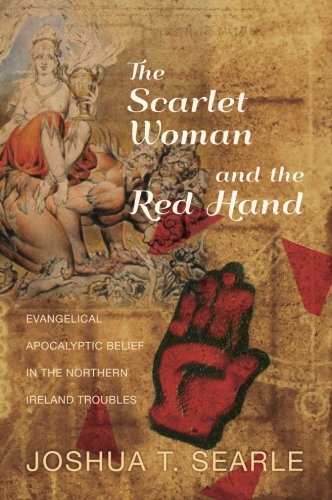 Pastor James McConnell’s provocative comments about Islam last month sparked outrage and indignation throughout Northern Ireland – as well as sympathy and defence from some quarters, it must be admitted. But I couldn’t help thinking that what McConnell said about Islam wasn’t all that different from what Rev Ian Paisley had been saying for years about Catholicism.
Pastor James McConnell’s provocative comments about Islam last month sparked outrage and indignation throughout Northern Ireland – as well as sympathy and defence from some quarters, it must be admitted. But I couldn’t help thinking that what McConnell said about Islam wasn’t all that different from what Rev Ian Paisley had been saying for years about Catholicism.
Joshua Searle, Tutor in Theology and Public Thought at Spurgeon’s College, London, sheds light on those segments of Northern Irish evangelicalism which continue to see the Catholic Church as a Satanic force, and the Pope as the Anti-Christ, in his new book: The Scarlet Woman and the Red Hand: Evangelical Apocalyptic Belief in the Northern Ireland Troubles (Pickwick Publications 2014).
Indeed, the ‘scarlet woman’ of Searle’s title is drawn from the book of Revelation, chapter 17:
“And the woman was arrayed in purple and scarlet colour, and decked with gold and precious stones, and pearls, having a golden cup in her hand full of abominations and filthiness of her fornication:
“And upon her forehead was a name written, MYSTERY, BABYLON THE GREAT, THE MOTHER OF HARLOTS AND ABOMINATIONS OF THE EARTH.
Evangelicals like Paisley have long interpreted the Scarlet Woman as a symbol of the Catholic Church.
Despite his kinder, cuddlier image since entering the Executive with Sinn Fein in 2007, Paisley’s website (the European Institute of Protestant Studies) still contains sermons and essays that condemn the Catholic Church in strong language. That includes a sermon directly addressing the passage about the scarlet woman, preached by I.M. Haldeman in 1910, who is described as ‘one of the great fundamental prophets of the early 20th century.’
But Searle goes beyond describing how evangelicals like Paisley interpret select biblical texts. He offers compelling and fresh perspectives on a broad range of evangelical ideas about ‘apocalyptic eschatology.’* He introduces us to a range of ‘evangelical cultures’ and helps us understand how ideas about the end of the world matter in the world in which we live today.
*(The apocalyptic has to do with the destruction of the world, usually at the end of time, and eschatology has to do with theological interpretations of the end times. Searle is careful to distinguish between these terms but sees both as important for understanding evangelical beliefs, p. 15-24).
Searle acknowledges that some scholars and commentators have interpreted the apocalyptic rhetoric of Northern Irish evangelicals as a response to the violence of the Troubles. But rather than accepting conventional wisdom that he Troubles drove evangelicals to an unusual obsession with the end of the world, Searle emphasises the longevity and durability of their ideas, arguing that pre-existing biblical interpretations informed evangelicals’ responses to violence. As he writes (p. 85):
“Historians of Ireland have uncovered pervasive strands of millennial discourse which were deeply woven into the fabric of Irish history. These studies imply that apocalyptic language was not a product of specific instances of political crises but functioned as a set framework through which to interpret the apparent prophetic significance of prevailing social events and trends.”
Indeed, Searle finds no evidence of an increase in the use of apocalyptic language during periods of more intense violence during the Troubles, in evangelical publications or sermons. What’s remarkable is the consistent use of apocalyptic language over time.
Searle usefully analyses evangelicals’ apocalyptic ideas under three broad themes, each of which is taken up by a chapter in the book:
- Apocalyptic Fear: “In the last days perilous times shall come”
- Apocalyptic Hope: “And I saw a new heaven and a new earth”
- Apocalyptic Dualism: “Because thou art lukewarm, and neither cold nor hot, I will spue thee out of my mouth”
The chapters on fear and dualism contain the expected examples of Paisley and other evangelical/fundamentalist preachers, using colourful language to convey the urgency of the end times, including terms like “synagogue of Satan” to describe “apostate” churches such as the Catholic church or Protestant churches with ecumenical sympathies.
Beyond those preachers, though, Searle provides examples of how such fearful and dualistic discourses crept into the language of mainstream unionist political parties, encouraging an attitude of no compromise (or “no surrender”). He quotes a 1977 Ulster Unionist Party election pamphlet (p. 199):
“The Ulster Unionist party will continue to press for total victory over the terrorist forces. There can be no compromise.”
More surprising is the chapter on Hope, which contains analysis of what Searle calls ‘Transformative Apocalyptic Eschatological Hope’ (p. 152ff). Here, Searle engages in particular with the work of Evangelical Contribution on Northern Ireland (ECONI) through its magazine Lion and Lamb, and other publications.
Searle traces the influence of theologians such as Jurgen Moltmann, Stanley Hauerwas and John Howard Yoder on this ‘culture’ of evangelicalism, arguing that it developed ‘apocalyptic eschatology as a social critique,’ and used traditional apocalyptic biblical texts ‘to overcome conventional sectarian distinctions, particularly between “Protestant” and “Catholic”, and thereby to support peace-building and reconciliation initiatives’ (p. 154).
But while the evangelicals of ECONI read these texts as a call to peace activism, traditional evangelicals ‘tended to read the same texts more as exhortations to remain faithful in the midst of apostasy than to work for social justice’ (p. 159-160).
Searle’s careful analysis of the variety of cultures within Northern Irish evangelicalism, and the diverse ways in which they have interpreted apocalyptic texts, will be of interest to a general audience concerned with the role of religion in Northern Ireland.
His book will also appeal to those interested in the roots of some of the fearful and dualistic discourses that continue to be used in Northern Ireland. Searle’s precise attention to language clearly show the links between evangelicals’ apocalyptic language and interpretations of scripture, and wider unionist approaches to politics and political compromise.
Priced at under £15 on amazon, it is more affordable than many academic tomes.
Academic readers will find plenty to chew on in his engagement with critical theory, hermeneutics, biblical studies and millennial studies. This analysis may be heavy going for a general reader, but it establishes Searle’s work in a wider body of international work.

Gladys is a Professor of Sociology at Queen’s University Belfast and a member of the Royal Irish Academy.
She is also a runner who has represented Ireland and Northern Ireland. She blogs on religion and politics at gladysganiel.com
Discover more from Slugger O'Toole
Subscribe to get the latest posts to your email.